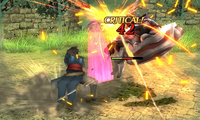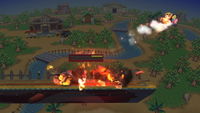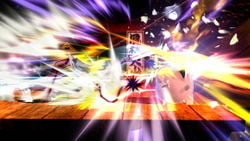Critical Hit
| Critical Hit | |
|---|---|
{{{content1}}}
{{{content2}}}
{{{content3}}} Marth, Lucina, and Roy's Critical Hit in Ultimate. | |
| User | Marth Lucina Roy |
| Universe | Fire Emblem |
| Article on Fire Emblem Wiki | Critical hit |
Critical Hit (必殺の一撃, Sure-Killing Blow) is Marth's Final Smash in Super Smash Bros. Brawl and Marth, Lucina, and Roy's Final Smash in Super Smash Bros. 4 and Super Smash Bros. Ultimate.
Overview
It involves the character delivering an immensely powerful slash that deals a devastating amount of knockback, more than enough to one-hit KO if directly in the line of sight of a blast line (with the exception of Roy's version). If it hits, a HP gauge from Fire Emblem is displayed alongside each hit character, which starts at full and quickly drops to zero.
Origin
Critical hits are a staple feature of many role-playing video games (including other series seen in Smash, such as EarthBound, Final Fantasy, Xenoblade, and Dragon Quest). They are generally rare attacks that have a certain chance of occurrence, with the payoff usually being an increase to the amount of damage dealt, e.g. doubling the current amount. In Fire Emblem, critical hits inflict three times the damage that a normal strike would (with the exception of Genealogy of the Holy War and Thracia 776), and the odds of executing them are based on the unit's skill stat and on the properties of the weapon they wield. The Critical Hit Final Smashes reflect the source material's extreme power—often far more than enough to kill an enemy in a single hit—with their high damage output and, in particular, the extremely high knockback of Marth and Lucina's shared version.
Executing a critical hit in Fire Emblem is almost always accompanied with a distinctive, flashy attacking animation, and these animations form the basis of each of the two Critical Hit Final Smashes. Marth and Lucina's shared version loosely resembles Marth's animation when performing a critical hit with Falchion, Mercurius or a rapier in Fire Emblem: Shadow Dragon and the Blade of Light. Roy's Critical Hit is a near-exact match for his attacking animation while wielding the Binding Blade in Fire Emblem: The Binding Blade, right down to the airborne version's recovery flip, performed in all cases in his game of origin when Roy sheaths the sword after striking; this animation is identical for all attacks he makes with the Binding Blade, although it only catches on fire, as it does in Smash, for critical hits and long-ranged attacks.
The gauges that appear with Critical Hit are a nod to the hit point health system used in Fire Emblem, and are designed to resemble the HP gauges used in specific games. In Brawl, Marth's gauge resembles that of Fire Emblem: Mystery of the Emblem, and contains 52 units of HP, matching the maximum possible amount of HP in Shadow Dragon and the Blade of Light and Mystery of the Emblem (though their remakes increased this to 60). From Smash 4 onward, the gauge used for all three characters is patterned after that of Fire Emblem Awakening and counts 80 units of HP, again matching the maximum possible HP in that game under ordinary circumstances.
In more recent games, units announce their critical hits (and special skills such as Aether) with a bright flash and by uttering a dramatic quotation. Lucina's utterance of "Time to change fate!" in her Final Smash is taken directly from this: in Awakening and subsequent games, the Japanese version of the line, 運命を変えます! ("I will change fate!") is one of her critical hit/special skill lines. The line is usually translated "I challenge my fate!" in English Fire Emblem localizations, but not in Smash.
In Smash
Marth and Lucina
The user raises their sword in the air, where it catches the light and shimmers brightly, before dashing forward with blazing speed to catch any unfortunate opponents with an extremely powerful slash. In all installments, Marth does not say anything while performing this move (apart from a simple grunt).
In terms of knockback, it is by far the strongest Final Smash in Brawl, SSB4 and Ultimate, and its power and damage also make it one of the strongest attacks in all of the games that it appears in. It deals 62% damage in Brawl (60% base plus 2% fresh) and deals more than enough knockback to KO any character at 0% under most normal circumstances. However, the power of this move is somewhat hampered by its larger time frame in which to perform a dodge (the time during which the user raises their sword), making it deceptively predictable and avoidable. Landing the blow is hence easiest against opponents suffering from ending lag or helplessness, or who are simply unaware, as all other players in range can completely dodge the move by air dodging, sidestepping, or simply moving away with good timing. In Brawl, Marth can also get a guaranteed Critical Hit if he forces his opponent into an aerial grab release, although this only works on some characters. In SSB4 and Ultimate, the startup slows down time by a slight amount, making the main attack harder to dodge.
Until the attack animation completely ends, the entire sword carries the move's hitbox, meaning that the attack can also hit anyone directly behind the user when they raise their sword. Because the attack itself gives such an high amount of freeze frames, it is also possible for a fighter to walk into the user's sword once it hits another opponent and still be given a OHKO, even after half a second. Critical Hit only hits once, so with proper timing, moves that provide armor can be used to survive it. Of course, this will not stop the target from taking the move's full damage.
On the ground, the initial dash will follow the platform's contours, and the move will end without the user swinging if they reach the edge. In the air, the user will travel at high speed directly forward. The dash can be canceled immediately by pressing an attack button, which also causes the user to swing their sword. The dash will automatically travel its maximum distance if uninterrupted, which is approximately the same distance as the width of the largest area available in Brawl's Stage Builder; missing with this attack on the ground on a walk-off stage, or in the air without any intervening terrain, usually results in a self-destruct unless the player manually cancels the user's dash. The distance the Final Smash grants allows it to be used as an extremely effective horizontal recovery move if needed, although this is situational.
In Brawl, this attack has such immense knockback that it is possible for the main victim to KO other opponents by simply knocking into them.
In Super Smash Bros. 4, Critical Hit can ignore all forms of armor. It was also given to Marth's clone Lucina, with identical functionality. When she performs the move, Lucina announces "Time to change fate!" (運命を変えます!, I will change fate!) instead of merely grunting.
Roy
Roy's Critical Hit involves him standing in place while spinning the Binding Blade in a backwards arc around him with two hands. It then flashes with light (similar to the startup of Marth/Lucina's shared Critical Hit) before Roy swings his sword violently downwards, creating a massive fiery explosion in front of him. Roy will then sheathe his sword (a purely aesthetic animation that ends in a second); if he finishes the Final Smash in the air, he leaps a small distance upward, which does not count as a second jump. The flaming slash deals 40%, and anyone hit by it is sent flying with high knockback, although the slash is not a OHKO unlike Marth/Lucina's shared version which can KO at any percentage under normal circumstances, and deals considerably less knockback at 0%, making it unable to KO fresh stocks (starting to KO only at 40%).
Unlike Marth/Lucina's shared Critical Hit, it is possible to force opponents into the final, powerful hit; touching the Binding Blade during the move's startup (when Roy slowly circles his sword) traps victims within the swing, dealing multiple 1% hits while it moves. A total of 11% can be dealt by the startup alone, and the final hit positions trapped opponents in front of Roy, making them vulnerable to the brunt of the finishing blow. As the swing starts from behind, it is easier to catch opponents behind Roy when compared to the front.
Because Roy's Critical Hit does not involve him moving forward, the range of his version is severely lower than Marth/Lucina's. The hitbox of the flaming slash also does not cover below Roy, making it possible to miss if Roy jumps and unleashes the move. However, the explosion itself has a large hitbox, and because the start of his Critical Hit can trap opponents into the final blow, it is more reliable at connecting and far less predictable than Marth/Lucina's Critical Hit, which has a highly predictable startup and a somewhat small hitbox; it even has a decently quick startup and can combo into Roy's throws at low percents, which can almost guarantee a KO.
Similar to Marth's/Lucina's, a purely aesthetic health bar appears for every victim sent flying, showing them dropping from full health to zero. However, Roy's variant of Critical Hit is not able to pierce through super armor.
Trophy Descriptions
Super Smash Bros. Brawl
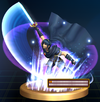
- Critical Hit
- Marth's Final Smash. He thrusts his sword skyward, then rushes to meet his targeted enemy with furious speed. The blow he strikes is so powerful that his foe is instantly launched off the screen. As in Fire Emblem, a window appears that shows the character's hit points dropping rapidly to zero--but this is just for effect. Smash Bros. does not use a hit-point system.
Super Smash Bros. for Wii U
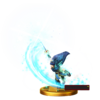
- Critical Hit (Marth)
Marth raises his Exalted Falchion to the sky and then rushes forward to deal an incredibly powerful blow, almost certainly KO'ing anyone and everyone who gets hit! When it's used in the air, he'll fly forward a certain distance. On the ground, however, he'll only dash to the edge of the platform he's standing on.
Marth raises his Exalted Falchion to the sky, then rushes forwards to deal an incredibly powerful blow, almost certainly KOing anyone and everyone who gets hit! When used in the air, he'll fly forwards a set distance, but on the ground, he'll only dash up to the edge of the platform he's standing on.
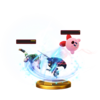
- Critical Hit (Lucina)
In Lucina's Final Smash, she raises her sword high before dashing swiftly forward to deliver a deadly blow to whomever she makes contact with first. Even if their damage is low, this strike is powerful enough to take out foes in a single hit. Just make sure you don't dash off the stage when you use it in midair!
In Lucina's Final Smash, she raises her sword high, then dashes swiftly forwards to deliver a deadly blow to whoever stands in her way. Even if their damage is low, this strike is powerful enough to take them out in a single hit. Just be careful not to dash off the stage if you use it in mid-air!
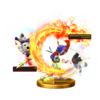
- Critical Hit (Roy)
- For Roy's Final Smash, he traps enemies in a circular swing of the blade, brings it up behind him, and then, in a blast of fire, brings the blade down for a powerful finisher! The downward attack is powerful on its own but doesn't have much range, so make sure you're close enough to hit your enemies with the full combo and really seal their fate!
Gallery
Critical Hit in Brawl
Marth's Critical Hit in Super Smash Bros. for Wii U.
Lucina's Critical Hit while dashing in Super Smash Bros. for Nintendo 3DS.
Lucina's Critical Hit in Super Smash Bros. for Wii U.
Lucina using Critical Hit in Super Smash Bros. for Wii U.
Trivia
- Marth's Final Smash is able to outrun the cars on Big Blue. In fact, it is even faster than Sonic wearing a Bunny Hood (who can also outrun the cars on Big Blue). However, the attack's ending lag will probably cause Marth to SD using it.
- Marth and Lucina's shared Critical Hit carries a special flinchless hitbox during the dash that negates the effects of the Metal Box, Super Mushroom, Poison Mushroom, and Lightning. If the move is used on a permanent metal character fought in Classic Mode or Special Smash, the opponent will instantly be forced back into their non-metal selves before being KOed.
- Critical Hit is one of the only Final Smashes shared by multiple characters, along with Light Arrow, Triforce Slash, Landmaster, Team Star Fox, Volt Tackle, PK Starstorm, and Grand Cross.
- The hitbox of Marth and Lucina's shared Critical Hit actually extends slightly beyond the tip of the sword; this can only be noticed by triggering the slash prematurely, as the slash will not automatically activate until the user collides with an opponent.
- Roy's Critical Hit actually does less damage and knockback than his fully charged Flare Blade.
- When Roy performs the Final Smash, his sheath appears during the attack but disappears when the attack is finished.
- Chrom is Marth's only clone or semi-clone to not utilize this Final Smash.
